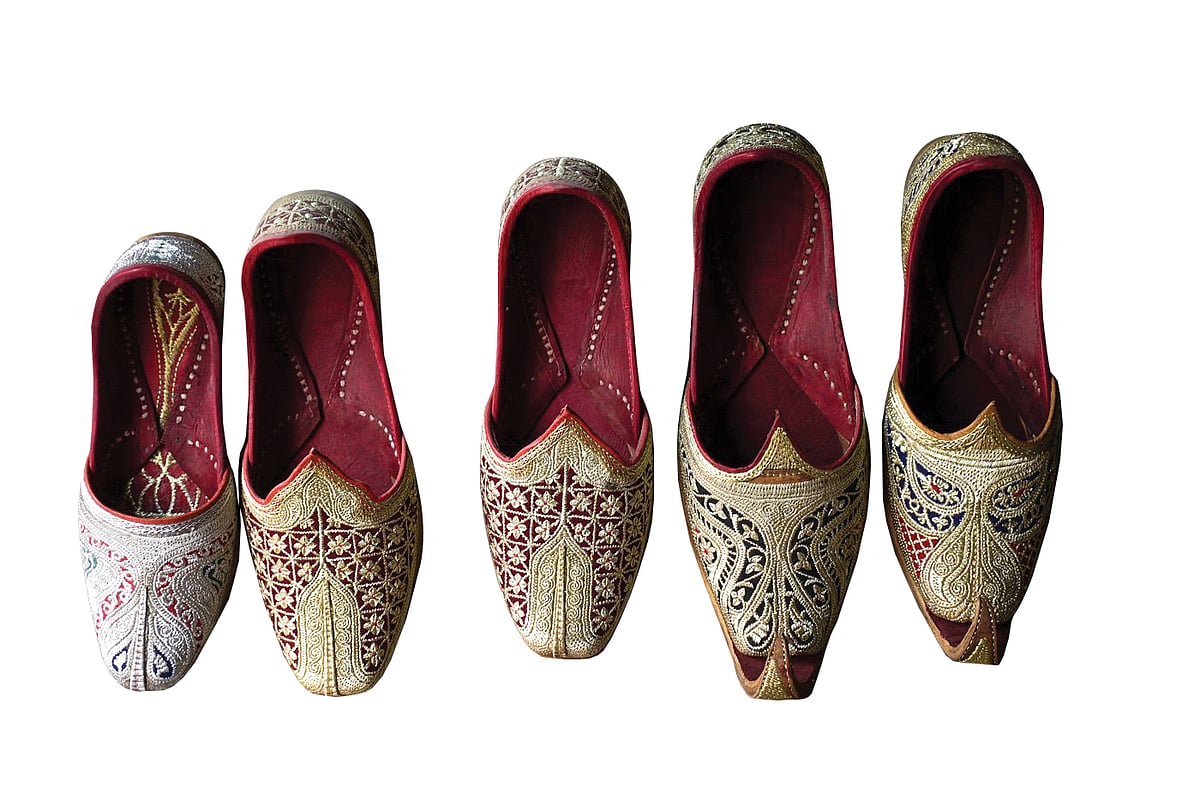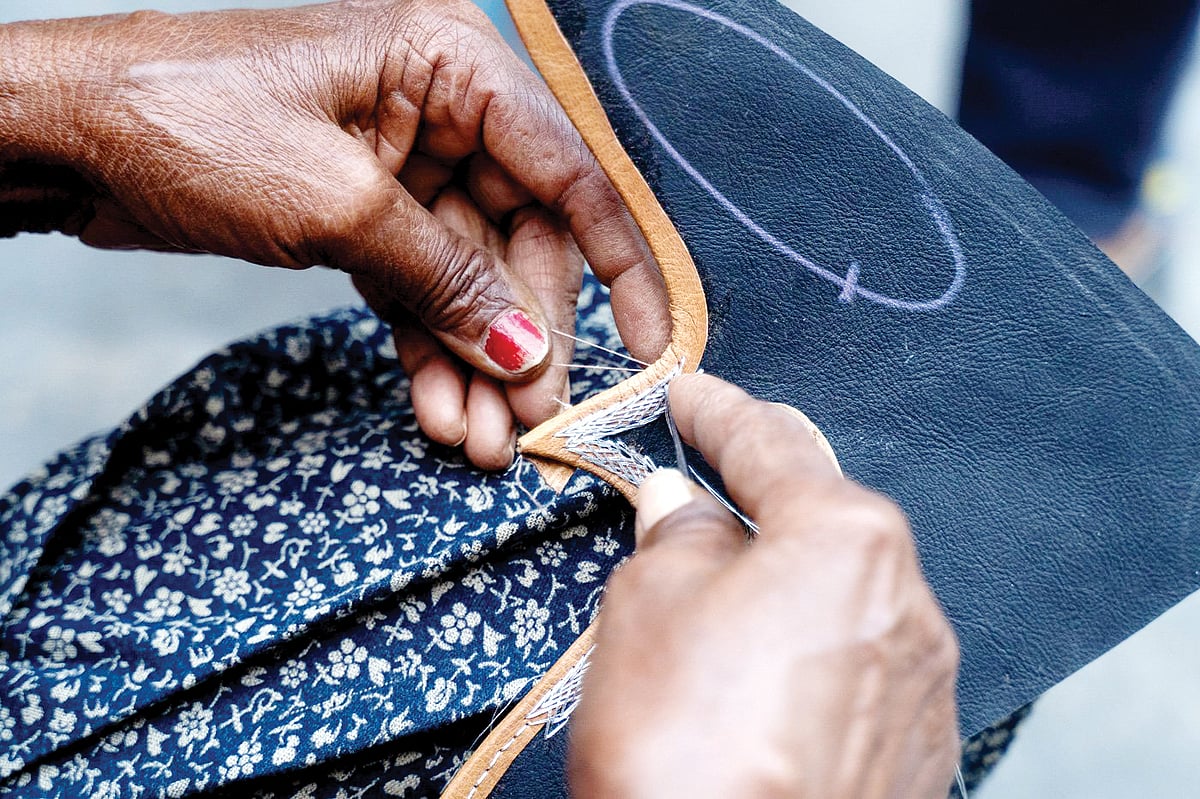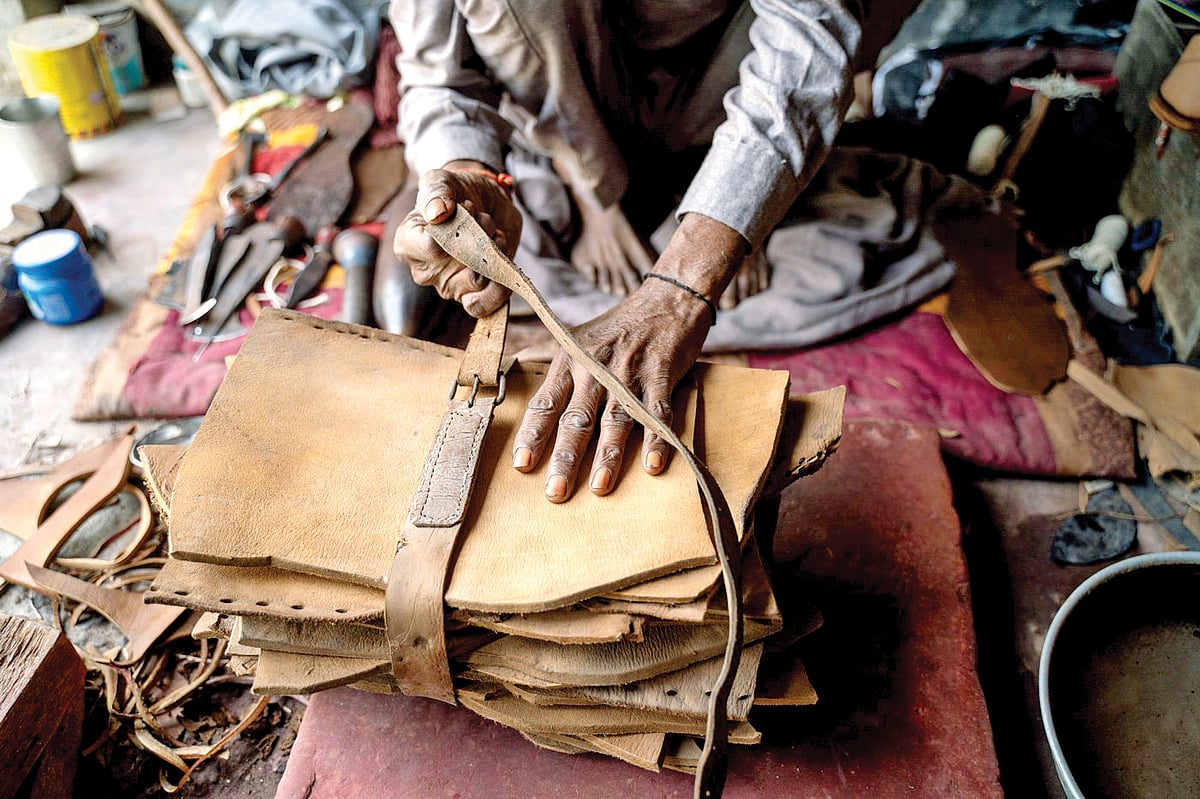‘No one can craft a jutti like I do’
In the village of Rupana in Sri Muktsar Sahib district of Punjab, Hansraj is the only artisan who makes traditional Punjabi juttis the traditional way

Hansraj tightens his grip on the coarse cotton thread. Using a sharp steel needle to guide it, the veteran shoemaker pierces the tough leather, skilfully moving the needle in and out roughly 400 times to hand-stitch a pair of Punjabi juttis (closed shoes). As he does so, his heavy sighs followed by ‘hmms’ punctuate the silence.
In the village of Rupana in Sri Muktsar Sahib district of Punjab, Hansraj is the only artisan who makes these shoes the traditional way. “Most people are unaware how a Punjabi jutti is made and who crafts it. There is a common misconception that machines make it. But from preparation to stitching, everything is done by hand,” says the 63-year-old artisan who has been in the business for nearly half a century now.
“Wherever you go, Muktsar, Malout, Gidderbaha or Patiala, no one can meticulously craft a jutti like I do,” Hansraj claims. Every day, starting at 7 a.m., he sits on a cotton mattress on the floor near the entrance of his rented workshop. The walls are covered with a collection of Punjabi juttis for both men and women. A pair can be priced between Rs 400 and Rs 1,600. He says he earns about Rs 10,000 a month from this, with an average workday of 12 hours.
“The body aches, especially the legs,” Hansraj says, massaging his knee joints. Hansraj learnt the craft when he was around 15, he was tutored by his father. “I was more interested in exploring the outdoors. Some days I would sit down to learn, some days I would not.” But as he grew up and the pressure to work increased, so did the hours of being seated.

Speaking in a mix of Punjabi and Hindi he says, “This work needs bariki (precision).” Hansraj has been working without glasses for years, but now, he says, he has started noticing changes in his eyesight. “If I work for many hours, my eyes feel the strain. I see two of everything.”
During a regular workday, he drinks tea and listens to the news, songs and cricket commentary on his radio. Old Hindi and Punjabi songs are his favourite.
Hansraj has never been to school, but finds great joy in exploring new places beyond his village, especially with his friend, a holy man in the neighbouring village. “Every year we take a trip. He has his own car, and he often invites me to join him on his travels.”
It is well past 4 p.m, and Rupana village is bathed in the warm glow of a lingering mid-November sun. One of Hansraj’s loyal customers has arrived with a friend to pick up a pair of Punjabi juttis. “Could you also make a pair for him by tomorrow?” the customer asks. The friend has come from far away — Tohana in Haryana — 175 km from here.
Hansraj smiles, responding to the customer’s request with a friendly, “Yaar, it is not possible by tomorrow.” The customer, however, is persistent. He then turns to us saying, “There are thousands of jutti shops in the city. But here in Rupana, it is only he (Hansraj) who crafts them by hand. We are familiar with his work.”
The customer tells us that up until Diwali, the entire shop was filled with juttis. A month later in November, only 14 pairs remain. What makes Hansraj’s juttis so special? “The ones he makes are flatter in the middle,” the customer says, “The difference lies in the hands [of the craftsperson].”
Hansraj doesn’t work alone. He gets some of the juttis stitched by Santram, a skilled shoemaker in his native village, Khunan Khurd, 12 km away. During Diwali or the paddy season, when the demand is high, he outsources his work, paying Rs 80 for stitching a pair.
The master shoemaker tells us the difference between a craftsman and a workman: “I always start by stitching the panna (upper portion) of the jutti from the tip of the sole. This is the most challenging phase of crafting juttis. The person who manages to do this right is a mistri (craftsman), others are not.”
It wasn’t a skill he learnt easily. “Initially, I was not good at stitching shoes with thread,” Hansraj recalls. “But when I committed to learning it, I mastered it in two months. The rest I picked up over time, first by asking my father, and later by observing him,” he adds.
Over the years, he has innovated a technique of stitching small strips of leather on both sides of the jutti, seamlessly connecting all the joints. “These small strips add strength to the shoes,” he explains.
Hansraj and his family of four — his wife Veerpal Kaur, their two sons and a daughter — relocated from Khunan Khurd to Rupana some 18 years ago. At that time, their eldest son, who is 36 now, began working at the paper mill in the village here.

“It was mostly [Dalit] families who made juttis in Khunan Khurd, working from their homes. As time passed, the new generation didn’t learn the craft. And those who knew, passed away,” says Hansraj. Today, in his old village, only three craftsmen — all from his community of Ramdasi Chamars (listed as Scheduled Caste in the state) — are still engaged in the art of handcrafting Punjabi juttis while Hansraj is the only one in Rupana.
“We saw no future for our children in Khunan Khurd, so we sold our property there and bought one here,” Veerpal Kaur says, her voice a mix of determination and hope. She speaks fluent Hindi, a result of the diversity in the neighbourhood which is populated by migrants from Uttar Pradesh and Bihar, many of whom work in the paper mill and live in rented rooms in the vicinity.
“When I started, a pair only cost Rs 30. Now a fully embroidered jutti can cost over Rs 2,500,” Hansraj recounts. From the small and large scattered pieces of leather at his workshop, Hansraj shows us two kinds: cowhide and buffalo hide. The buffalo hide is used for the sole, and the cowhide is for the upper half of the shoes, he explains.
As he holds up the tanned cowhide, he asks if we are comfortable touching the animal skin. When we express our willingness, he goes on to observe not just the tanned leather but the contrast. The buffalo hide feels as thick as 80 paper sheets stacked together. The cowhide, on the other hand, is much thinner, maybe around 10 paper sheets. In terms of texture, the buffalo hide has a smoother and stiffer feel, while the cowhide, though slightly rougher, exhibits greater flexibility and ease of bending.
Also Read: The lore of Chadar Badni puppets

The hike in leather prices and people’s inclination towards factory-produced shoes and slippers (what he calls 'boot-chappal') has led to a fall in the number of people willing to take up this profession.
Hansraj treats his tools with great care. For shaping the jutti he uses a rampi (cutter) to carve and scrape the leather; a morga (wooden hammer) for beating it until it is stiff. The wooden morga belonged to his father as did a deer horn which he uses to shape the tip of the shoes from inside.
The shoemaker travels to the shoe market in Jalandhar, 170 km away from his village, to buy tanned hides. To reach the mandi (wholesale market), he takes a bus to Moga and another from Moga to Jalandhar. His most recent journey took place two months before Diwali when he bought 150 kg of tanned leather, valued at Rs 20,000.
Has he ever faced any trouble carrying the leather, we ask him. “The concern is more about transporting untanned leather than the tanned one,” he clarifies. He visits the mandi to carefully choose the desired quality of leather, and the traders arrange for its transportation to Muktsar, from where he collects it.
Over the years, the material for making juttis has evolved and younger shoemakers like Raj Kumar and Mahinder Kumar of the Guru Ravidas colony in Malout say that materials like rexine and micro cellular sheets are now more commonly used. Raj and Mahinder, both in their early 40s, belong to the Dalit Jatav community.
“Where a micro sheet cost Rs 130 per kg, the cowhide now costs between Rs 160 and Rs 200 per kg,” says Mahinder. They say leather has become a rare commodity in the area. “Earlier, the colony was full of tanneries and the stench of untanned leather hung in the air. But as the basti grew, the tanneries were shut down,” says Raj.

Youngsters are no longer keen on joining the profession, they add, and low income is not the only reason. “The stench gets into our clothes,” Mahinder says, and sometimes their friends won’t shake hands with them.
“My sons never entered the shop to learn the craft. Ours is the last generation now to know the skill,” says Hansraj. As she chops vegetables for dinner, Veerpal Kaur says, “It isn’t possible to build a home by just making juttis.” Almost two years ago, the family completed the construction of a pucca house, facilitated by their eldest son’s employee loan from the paper mill.
“I had also asked her to learn embroidery, but she didn’t learn it all,” Hansraj says, teasing his wife. The two have been married for 38 years. “I wasn’t interested,” Veerpal chimes back. Based on what she learnt from her mother-in-law, she can embroider a pair in an hour at home with zari thread.
Their home, shared with their eldest son’s family of three, comprises two rooms, a kitchen, and a drawing room, with an outdoor toilet. Adorning the rooms and hall are photos of B.R. Ambedkar and Sant Ravidas. A similar image of the saint graces Hansraj’s workshop.
“It is in the last 10–15 years that people have started wearing juttis again,” Veerpal says.“Before that, many had also stopped asking for us shoemakers.” During that time, Hansraj worked as a farm labourer and occasionally crafted juttis within a day or two whenever a customer came by.
Courtesy: People’s Archive of Rural India (PARI). The full version of this article can be read at ruralindiaonline.org
Follow us on: Facebook, Twitter, Google News, Instagram
Join our official telegram channel (@nationalherald) and stay updated with the latest headlines